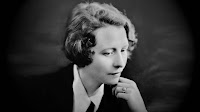“In the fall of the year,
in the fall of the year,
I walked the road beside my dear.
The rooks went up with a raucous trill.
I hear them still, in the fall of the year.
He laughed at all I dared to praise,
And broke my heart, in little ways.”—Pulitzer Prize-winning American poet and playwright Edna St. Vincent Millay (1892-1950), “The Spring and the Fall,” in The Harp-Weaver and Other Poems (1922)
A century ago this month,
Edna St. Vincent Millay became the first woman to receive the Pulitzer
Prize for Poetry. “The Spring and the Fall” was part of the collection that won
her the honor.
This poem, which I came
across in a school reader from 70 years ago, reminded me of why I have enjoyed
Millay. Read in its entirety, it touches on the “ecstatic passion [and] skepticism
of enduring love” that, New Yorker reviewer Maggie Doherty wrote in May 2022, represented the “great
themes” of the lyric poet.
I walked the road beside my dear.
The rooks went up with a raucous trill.
I hear them still, in the fall of the year.
He laughed at all I dared to praise,
And broke my heart, in little ways.”—Pulitzer Prize-winning American poet and playwright Edna St. Vincent Millay (1892-1950), “The Spring and the Fall,” in The Harp-Weaver and Other Poems (1922)
Over the last century, she has somewhat fallen out of favor with
critics, despite Nancy Milford’s well-received 2001 biography, selections from
the poet’s diaries published last year, and the heroic efforts of the Edna St.
Vincent Millay Society to preserve Steepletop, her longtime home in Austerlitz, NY.
No matter. Millay may be
one of those authors, like the novelist Thomas Wolfe, who survive, barely, on
high school and college curricula, but continue to find readers somehow.
You can find many
interesting posts on Millay on the blogosphere, but you might find especially thoughtful
this February 2021 post from the Farnsworth Art Museum that feature Maine
poets reading letters and poems that focus on Millay’s exploration of loss and
renewal—as well as their own poems in response to the COVID-19 pandemic,
personal loss, and the threat of global climate change.
It’s a welcome reminder
that, despite the intensely intimate nature of Millay’s early, best-known work,
she became increasingly engaged with national and world issues as time went on.)

No comments:
Post a Comment